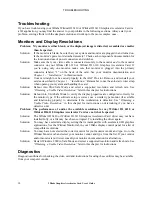
SOFTWARE CONFIGURATION
Enabling stereo display
If you connect a device to the stereo port on the Wildcat III 6210 or Wildcat III 6110, you must change
the display mode to view in stereo. See
Chapter 2, “Setup,”
for an illustration of the stereo output port.
1. Make sure your stereo display device is properly connected to the stereo output port on the
Wildcat III 6210 or Wildcat III 6110. See
Chapter 2, “Connecting a Stereo Display
Device”
for more information.
2. On the Wildcat III Monitor tab under Display Properties, click Configure Monitor. The
Configure Monitor dialog box displays.
3. Select one of the Stereoscopic Display modes from the Display Mode pulldown, then click
OK to return to the Display Properties dialog box. If you are prompted with the following
message: “The selected monitor cannot display the current desktop area. Select a new
resolution before applying these changes,” click OK then select a resolution from the list of
available resolutions.
4. Click OK if the display is correct and you wish to keep the new settings. The Display
Properties dialog box is dismissed.
5. Click OK to accept the new display mode and dismiss the Display Properties dialog box.
NOTE:
You must disable stereo mode when you no longer wish to view in stereo. Follow
the steps above, and select Monoscopic Display under Display Mode to disable
stereo mode.
Enabling Multiview and Genlock on the Wildcat III 6210
The Wildcat III 6210 comes with Multiview support for frame locking and rate locking of multiple
workstations. Genlock support allows video timing to be synchronized to an external timing source.
NOTE:
Your application must support Multiview for Multiview to work. Refer to the Wildcat
support area on http://www.3dlabs.com/support/troubleshooting/wc-01.htm for
information on ordering the correct cables.
IMPORTANT: Multiview on a Wildcat III 6210 is not compatible with Multiview on any
previous Wildcat product. Only connect Wildcat III 6210 cards together in a
Multiview configuration.
Enabling Multiview features
1. Insert one end of a shielded DB-9
cable into the Multiview Out port of the first
workstation. This workstation becomes the “Master.”
2. Insert the other end of the cable into the Multiview In port of the second workstation. This
workstation becomes a “Slave.”
3. If connecting more than two workstations, continue linking workstations to one another by
connecting the Multiview Out port of one workstation to the Multiview In port of the next.
The last workstation should terminate the links and only have a cable plugged into the
Multiview In port.
3Dlabs Graphics Accelerator Card User's Guide
24
Summary of Contents for P Class 450/500/550/600/650/700/750
Page 5: ...3Dlabs Graphics Accelerator Card User s Guide v ...
Page 6: ......
Page 7: ...CHAPTER 1 INTRODUCTION 3Dlabs Graphics Accelerator Card User s Guide ...
Page 12: ...INTRODUCTION 3Dlabs Graphics Accelerator Card User s Guide 6 ...
Page 13: ...CHAPTER 2 SETUP 3Dlabs Graphics Accelerator Card User s Guide ...
Page 25: ...CHAPTER 3 SOFTWARE CONFIGURATION 3Dlabs Graphics Accelerator Card User s Guide ...
Page 27: ...SOFTWARE CONFIGURATION 3Dlabs Graphics Accelerator Card User s Guide 21 ...
Page 35: ...CHAPTER 4 TROUBLESHOOTING 3Dlabs Graphics Accelerator Card User s Guide ...
Page 40: ...APPENDIX A SPECIFICATIONS 3Dlabs Graphics Accelerator Card User s Guide ...
Page 44: ...SPECIFICATIONS 3Dlabs Graphics Accelerator Card User s Guide 38 ...
Page 45: ...APPENDIX B SOFTWARE LICENSE 3Dlabs Graphics Accelerator Card User s Guide ...
Page 50: ......
Page 51: ...APPENDIX D TERMS AND DEFINITIONS 3Dlabs Graphics Accelerator Card User s Guide ...
Page 56: ...TERMS AND DEFINITIONS 3Dlabs Graphics Accelerator Card User s Guide 52 ...
Page 57: ...INDEX 3Dlabs Graphics Accelerator Card User s Guide ...
Page 59: ...INDEX Safe mode 31 3Dlabs Graphics Accelerator Card User s Guide 55 ...






























